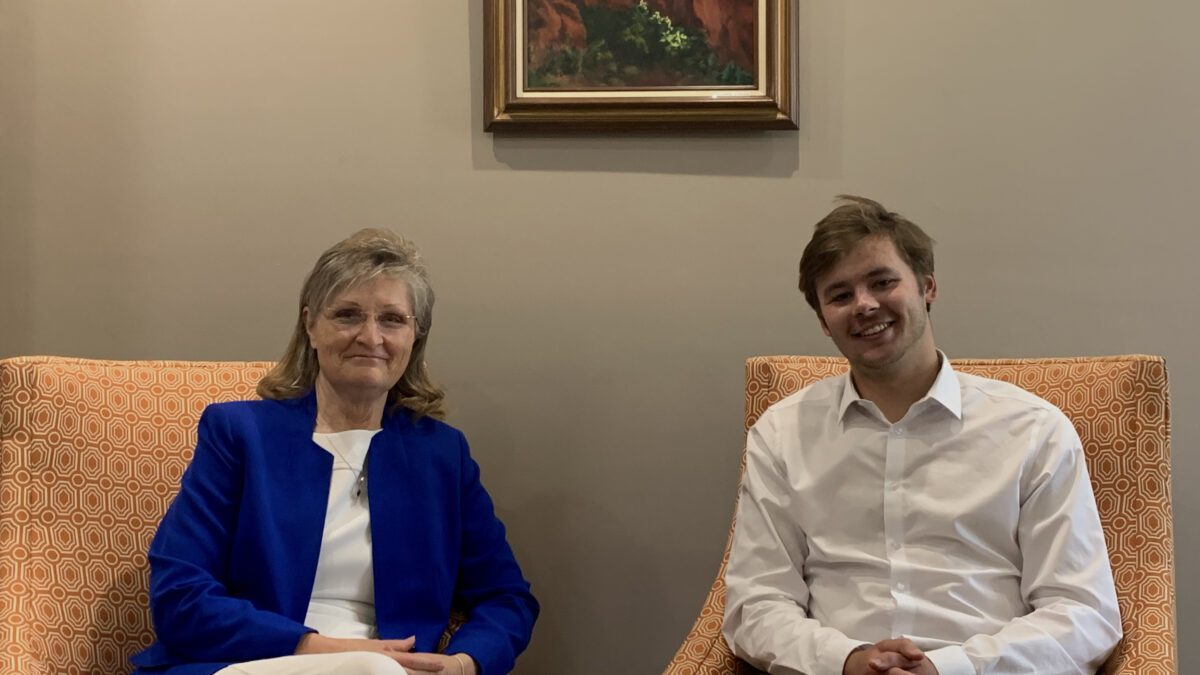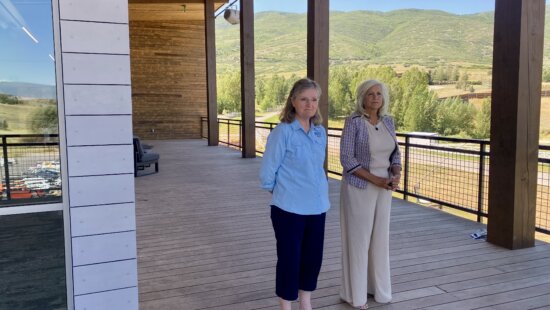Politics
Fire at Will: Heber City Mayor Heidi Franco

Heber City Mayor Heidi Franco and TownLift Reporter Will Scadden. Photo: TownLift
HEBER CITY, Utah – In this descriptive and ongoing series, which will be published every Friday, I will participate in thought-provoking discussions with various elected leaders and important persons from Summit and Wasatch Counties. My goal with each interview is to delve into the substance of their professions, providing light on the vast responsibilities and expectations that come with holding public office.
In this series, we’ll also talk about their thoughts on the important issues that affect their residents and the steps they’ve made to allay their worries and support progress in their communities.
This week consists of an extensive conversation with Heber City’s Mayor Heidi Franco.
Franco was born and raised in Utah, albeit on the other side of the mountains, and is a long time resident of Heber City. Franco is from Pleasant Grove, and later attended Brigham Young University where she would earn a bachelor’s degree in Political Science and eventually a master’s degree and PhD in Public Administration.
Since graduating, Franco has engaged in politics in a few different ways, participating in numerous campaigns and instructing political science courses for over 25 years at four different universities in Utah, namely the University of Utah, Brigham Young University, Utah Valley University, and Western Governors University.
“Once you get bitten by that government bug, you just become committed to how important it is,” Franco said of her passion for teaching and working in government. “It’s been very interesting to teach and see the different philosophies that people have, and it’s just been a real treat for me to help thousands of students learn about government and about the standards of government.”
In addition to her extensive education background, Franco has leveraged her skills to actively engage in politics and contribute to the community. Since 2014, she has held elected office, starting with her first election to the Heber City Council. Demonstrating her commitment, Franco served two terms as a City Council member before being elected as Mayor in January of 2022.
Similar to Park City Mayor Nann Worel, Franco feels that her time serving on the City Council adequately prepared her to take the leap into the Mayor’s office.
“I’m the longest serving person now on the city council. So to be able to say this is why we did something back then, and this was the issues back then, has been very helpful,” Franco explained. “I’ve seen how the budgets have changed over time, and seen the increase of employees we have. When I was elected, we were just coming out of the Great Recession. We used to argue about $300,000 as the extra money in the budget, and now we’re debating about millions. It’s just phenomenal to see the growth and the changes in Heber City firsthand.”
Franco spends her day-to-day doing varying tasks, mainly responding to emails and citizen inquiries, and also, similarly to Mayor Worel and Mayor McCormick, Franco sees herself as a conduit between citizens and local, state, or county government.
“Day-to-day I’m spending quite a few hours on emails, either related to city business or citizen complaints, nudging people along, and trying to get issues resolved,” Franco said of her daily routine. “I think the mayors are kind of like an ombudsman, to help citizens know where to go and who to talk with. I try to help people move forward with government processes, and help them get issues resolved.”
Another part of Franco’s job entails acting as the chair of the City Council, controlling the direction of meetings.
“I chair the City Council, so I’ll direct all the meetings, take all the motions, call all the votes, and put things on the city agenda,” Franco explained. “I participate as much as the other council members, but I don’t get to vote. I can only vote if there’s a tie, and the Heber City Mayor has no veto power.”
Of the Mayor’s biggest responsibilities, Franco believes sitting and participating in several committees, including the City Council, constitute her most important role.
“I attend 17 meetings a month for city business and city county boards, and I get to vote on those boards and help push issues through,” Franco said. “Those are the major utility boards, the power company, and the sewer district. I’m also the chair of the Wasatch open space board, which is a county board to help preserve open space in our county.”
“I try to make sure that the city’s doing as good of a job as it can,” Franco said. “That’s the political science professor coming out in me, this is what I teach and what I study. We have to build the capacity in the city and be accountable. Capacity, accountability, transparency, and participation from the public will equal our legitimacy and trust from our citizens.”
Since taking office as a City Council member in 2014, one of the biggest changes Franco has noticed since entering public office has been the dramatic growth in and around Heber City.
“I keep thinking that I wish we could go back to those days, when we were worried about putting up stop signs in every intersection,” Franco said. “I thought that was a big deal, making sure that every intersection was regulated because we had totally unregulated intersections across the whole city, except for Main Street.”
Heber City has evolved from debating about stop signs to debating about where to build a new highway bypass, a process Franco has been actively involved in.
The main goal of the bypass is to reduce the amount of oil tankers driving through Heber City’s downtown district, as Mayor Franco estimates over 300 t0 600 tankers drive through Heber City on a daily basis.
“Nobody wants the diesels on Main Street, and the number one goal [of the bypass] is to get the diesels off Main Street,” Franco explained. “I’ve heard it go from 300 to 600 diesel trips a day in our city, and they can be two to three tankers long.”
“Everyone wants a bypass to get the diesels off of Main Street and bring them around, whether it was on the east side or west side of the city,” Franco said while demonstrating on a map. “The previous mayor worked strongly with UDOT to get funding from the state legislature, so they would actually do a study, pick a route, and do the environmental assessment. UDOT first came up with 20 routes, then narrowed it down to 13, and now they’ve narrowed it down to five.”
Of UDOT’s five routes for the new bypass, two of them extend directly through Heber Valley’s north fields, an area that is sacred to many Wasatch County residents.
It is important to note that neither Heber City or Wasatch County has control over highway U.S.-40 or the new bypass, as the highway and the new bypass will be controlled by the state and UDOT.
“We’re not in charge of building that road,” Franco said of the new bypass. “The city and the county have worked extensively for the last decade to provide the right of way. The county has bought the right of way for the original route, which went around the city on the west side.”
While UDOT will control the new bypass and all construction, Heber City and Wasatch County will be somewhat involved in the decision making process of the new bypass.
“We were told nine years ago that if we had a standard for a road like that, UDOT would follow our standards,” Franco said of the bypass. “So we adopted an ordinance if they were to build a scenic bypass road, they would have to put in trails, they would have to have berms, landscapes, and a divided landscape medium. The county also adopted standards like that and as far as I’ve heard, we’ve never heard anything different from UDOT at this point.”
UDOT is still in the environmental impact statement portion of their survey, which is expected to be completed this fall. Although there has been progress with the bypass, UDOT has told Mayor Franco that completion could still be up to a decade away.
“They’re [UDOT] saying that it could take a decade to build that road, but a decade away is still ten years away,” Franco said. “Our City Council, we want downtown revitalization, we want improvements, we want landscape medians down Main Street, but that’s all waiting until a bypass road is hopefully built.”
In addition to contemplating the new bypass road, Mayor Franco also has to juggle all the new developments and annexations that are happening, which are predicted to double the population of Heber City.
Several new developments north of Heber City along U.S.-40 and the Jordanelle Reservoir have been recently annexed into Heber City limits, which are planned to build thousands of units.
“We’ve doubled the size of our city, plus we’ve certainly doubled the geographic size of our city,” Franco explained. “This has all been in the last three to four years so you can imagine how intense negotiations have been. To bring in all these separate annexations there’s a ton of work in the City Council, as well as a whole new design code, new parks, new trails, amenities code, and we worked through all the details on affordable housing.”
Franco also explained how annexations are conducted.
“It’s usually the developers that have bought the land and have sat on it literally for a couple of decades. They went to the county and got approved for really high density developments a decade plus ago,” Franco said. “Then their approval either ran out with the county or was about to run out, and they came to the city, and I was interested in annexing them on the City Council because the amount of density that the county gave meant that they would be another city.”
“They’re doubling the population, and they would be another city right on our north border,” Franco explained. “And the majority view of the city council, when they first started to come to us, four or so years ago, was that we don’t want another city right on our doorstep. So if they want to come in and be annexed, that’s fine.”
Due to proactive thinking of the City Council, a positive of all the new developments in Heber City will be the availability of affordable housing once construction is complete.
“Heber City is ahead of the curve due to a previous council member named Ron Crittendon. Five years ago, he was able to get a city ordinance passed that in every single development 10% bonus density will be given, so that 10% could go to affordable housing at the eight 80% AMI,” Franco explained.
“Because of his good work, for the next five years 513 affordable housing units will be coming online in many different places within our city,” Franco said. “Over the next 30 years, we already have another 500 Plus units lined up. Now most of that is coming from the new annexations we negotiated, but there’s also the two self help projects in town.”
In addition to negotiating several annexations and managing a new bypass, Mayor Franco has also managed to adopt policies to protect air and environment quality in the valley, and she has enacted measures to ban wood-burning stoves and protect water quality by implementing higher standards on new developments to protect the quality of water runoff.
Franco has also been busy preserving open space in the valley, and been proactive as a member of the Wasatch Open Lands board.
“We use $10 million of open space fund money to leverage it as many times as we could to save agriculture in the valley or in the county, we’re particularly focused on the valley floor, but it’s always a voluntary landowner that has to come and make the application,” Franco said of the initiative to preserve open land.
“We’ve already saved over 200 acres with working and leveraging that ($10 million Open Space funding) many, many times over. And we have several other projects lined up to save hundreds more acres, especially in the north fields, which have that high water table, which tie wetlands there into the valley floor aquifer.”
Franco is only a year and a half into her first term as Mayor, and is not yet considering reelection, but places importance on the upcoming City Council elections this year.
“We have three on the city council up for reelection this year, which is a majority vote. This is a critical election, and we can really determine whether Heber City continues to go growth, growth, growth, growth, as fast as we can, or whether what I ran on, if we want responsible growth that will protect the quality of life will protect the natural resources.”



















